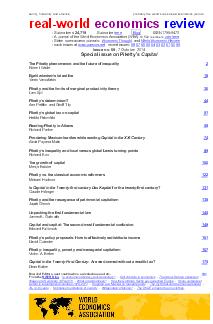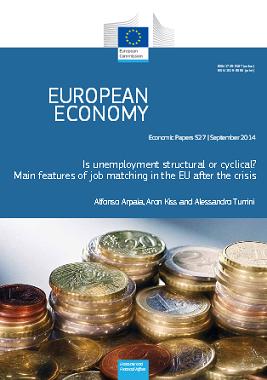World Economics Association (WEA) Real-World Economics Review, Issue no. 69, 07 October 2014 Special Issue on Piketty’s Capital. Economists and other social scientists tend to study “problems”. Issues not studied tend to be seen as “natural”. “Poverty” and the “poor” are problems, the subject of a vast social science literature. Inequality, income concentration, the behaviour and influence of the super-rich tend to be treated as part of the natural …Read More
Systemic equilibrium in a Bretton Woods II-type international monetary system: the special roles of reserve issuers and reserve accumulators
Austin, Κ. (2014) “Systemic equilibrium in a Bretton Woods II-type international monetary system: the special roles of reserve issuers and reserve accumulators“, Journal of Post Keynesian Economics, 2014, vol. 36, issue 4, pages 607-634. This article develops a model, based on balance-of-payment identities, of the new international monetary system (Bretton Woods II or BWII). It shows that if some countries engineer current account surpluses by exchange-rate manipulation and foreign-reserve …Read More
Electricity Tariff Deficit: Temporary or Permanent problem in the EU?
Johannesson Linden, Α., Kalantzis, F., Maincent, E. & Pienkowski, J. (2014) “Electricity Tariff Deficit: Temporary or Permanent problem in the EU?“, European Economy. Economic Papers. 534. October. In the recent years electricity tariff deficits emerged in Spain, Portugal, Greece and in some other Member States. Tariff deficits are shortfalls of revenues in the electricity system, which arise when the tariffs for the regulated components of the retail electricity price …Read More
The Effects of a Money-Financed Fiscal Stimulus
Galí, J. (2014) “The Effects of a Money-Financed Fiscal Stimulus“, Centre for Economic Policy Research, 24 September. I analyze the effects of an increase in government purchases financed entirely through seignorage, in both a classical and a New Keynesian framework, and compare them with those resulting from a more conventional debt-financed stimulus. My findings point to the importance of nominal rigidities in shaping those effects. Under a realistic calibration …Read More
Why Italy Will Not Make It
Orsi, R. (2014) “Why Italy Will Not Make It“, LSE EUROPP, Eurocrisis in the Press, 01 October. Three articles by prestigious commentators (Ambrose Evans-Pritchard and Roger Bootle for The Telegraph, Wolfgang Münchau for Financial Times) have recently appeared in the financial press about the economic situation of Italy and the (in)stability of its national debt. The arguments and wording of these pieces deserve special attention, as their appearance may …Read More
Re-discovering the Phillips curve
Andor, L. (2014) “Re-discovering the Phillips curve“, VoxEU Organisation, 01 October. Negative real interest rates imply redistribution from savers to debtors. This column, by the EU Commissioner for Employment, Social Affairs and Inclusion, argues that such redistribution would benefit the whole economy. It would strengthen aggregate demand – including investment demand – at time when such a boost is clearly needed. As a contribution to the EU’s institutional transition, …Read More
Modelling sticky prices and the effect of monetary shocks
Alvarez, F., Le Bihan, H. & Lippi, F. (2014) “Modelling sticky prices and the effect of monetary shocks“, VoxEU Organisation, 30 September. The assumption of sticky prices is central in understanding the effect of monetary policies on the economy. Yet, how to best model price stickiness is an unresolved issue. This column assesses a selection of models that are able to reproduce cross-sectional heterogeneity in the setting of prices. …Read More
Small business productivity and access to financing
Krishnan, K., Nandy, D. & Puri, M. (2014) “Small business productivity and access to financing“, VoxEU Organisation, 26 September. The greater access to capital could increase small firms’ investment efficiency. Others argue that it may result in wasteful expenditures. This column discusses how small firms were affected by the Interstate Banking and Branching Efficiency Act of 1994, which allowed interstate banking. The authors find an increase in the productivity …Read More
What macroeconomic policies for the Eurozone?
Giavazzi, F. & Tabellini, G. (2014) “What macroeconomic policies for the Eurozone?“, VoxEU Organisation, 25 September. In a recent column, the authors suggested coordinating monetary and fiscal expansions in the Eurozone through a money-financed temporary tax cut. The effectiveness of their proposal, however, has been questioned. In this column, the authors address some of the criticisms. They argue that the counter-cyclical fiscal policies adopted by the US and the …Read More
Is unemployment structural or cyclical? Main features of job matching in the EU after the crisis
Arpaia, Α., Kiss, A. & Turrini, A. (2014) “Is unemployment structural or cyclical? Main features of job matching in the EU after the crisis“, European Economy, European Commission Economic Papers 527, September. The paper sheds light on developments in labour market matching in the EU after the crisis. First, it analyses the main features of the Beveridge curve and frictional unemployment in EU countries, with a view to isolate …Read More







